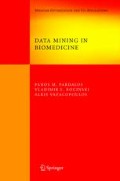Abstract
Alport syndrome is a genetic multi-organ disorder, primarily linked with the X-Chromosome, although autosomal forms have been reported. Ultra-structural observations in some cases indicate highly characteristic lesions and mutations in certain genes. Thus the symptomatology of the syndrome is complex and diverse. The aim of this chapter is to present a pattern recognition algorithm to diagnose with high precision patients who may be subject to Alport syndrome. Images of the epidermal basement membrane are studied and a rule to classify them precisely is presented. Theoretical and experimental results are given regarding the possibility of solving this problem.
Access this chapter
Tax calculation will be finalised at checkout
Purchases are for personal use only
Preview
Unable to display preview. Download preview PDF.
References
G. Addonisio. Tecnica di classificazione per la diagnosi della sindrome di Alport. Technical report, Laurea Thesis Universita di Roma La Sapienza Facoltà di Statistica, 2002.
P. Barsotti, A. Onetti Muda, G. Mazzucco, L. Masella, B. Basolo, M. De Marchi, G. Rizzoni, G. Monga, and T. Faraggiana. Distribution of alpha-chains of type IV collagen in glomerular basement memebranes with ultrastructural alterations suggestive of Alport syndrome. Nephrology Dialysis Transplantation, 16:945–952, 2001.
G. Bonifazi, P. Massacci, L. Nieddu, and G. Patrizi. The classification of industrial sand-ores by image recognition methods. In Proceedings of 13th International Conference on Pattern Recognition Systems, Vol.4: Parallel and Connectionist Systems, pages 174–179, Los Alamitos, CA, 1996. IEEE Computer Society Press.
L. Devroye, L. Gyorfi, and G. Lugosi. A Probabilistic Theory of Pattern Recognition. Springer-Verlag, Berlin, 1996.
R. O. Duda and P. E. Hart. Pattern Recognition and Scene Analysis. Wiley, New York, 1973.
E. P. Goss and G. S. Vozikis. Improving health care organizational management through neural network learning. Health Care Management Science, 5:221–227, 2002.
H. S. Konjin. Statistical Theory of Sample Design and Analysis. North Holland, Amsterdam, 1973.
L. Massella, K. Giannakakis, A. Onetti Muda, A. Taranta, G. Rizzoni, and T. Faraggiana. Type VII colagen in Alport syndrome. Journal of the American Society of Nephrology, 13:309, 2002.
G. Mazzucco, P. Barsotti, A. Onetti Muda, M. Fortunato, M. Mihatsch, L. Torri-Tarelli, A. Renieri, T. Faraggiana, M. De Marchi, and G. Monca. Ultrastructural and immunohistochemical findings in Alport’s syndrome: A study of 108 patients from 97 italian families with particular emphasis on col4a5 gene mutation correlations. Journal of Nephrology, 9:1023–1031, 1998.
S. Meleg-Smith, S. Magliato, M. Cheles, R.E. Garola, and C.E. Kashtan. X-linked Alport syndrome in females. Human Pathology, 29:404–408, 1998.
G.L. Nemhauser and G.L. Wolsey. Integer and Combinatorial Optimization. Wiley, New York, 1988.
L. Nieddu and G. Patrizi. Formal properties of pattern recognition algorithms: A review. European Journal of Operational Research, 120:459–495, 2000.
G. Patrizi. Optimal clustering properties. Ricerca Operativa, 10:41–64, 1979.
G. Patrizi, L. Nieddu, P. Mingazzini, F. Paparo, Gr. Patrizi, C. Provenza, F. Ricci, and L. Memeo. Algoritmi di supporto alla diagnosi istopatologica delle neoplasie del colon. Associazione Italiana per l’Intelligenza Artificiale (AI*IA), 2:4–14, 2002.
V. N. Vapnik. Learning Theory. Wiley, New York, 1998.
S. Watanabe. Pattern Recognition: Human and Mechanical. Wiley, New York, 1985.
T. Y. Young and W. Calvert. Classification, Estimation and Pattern Recognition. Elsevier, New York, 1974.
Author information
Authors and Affiliations
Editor information
Editors and Affiliations
Rights and permissions
Copyright information
© 2007 Springer Science+Business Media, LLC
About this chapter
Cite this chapter
Patrizi, G., Addonisio, G., Giannakakis, C., Muda, A.O., Patrizi, G., Faraggiana, T. (2007). Diagnosis of Alport Syndrome by Pattern Recognition Techniques. In: Pardalos, P.M., Boginski, V.L., Vazacopoulos, A. (eds) Data Mining in Biomedicine. Springer Optimization and Its Applications, vol 7. Springer, Boston, MA. https://doi.org/10.1007/978-0-387-69319-4_13
Download citation
DOI: https://doi.org/10.1007/978-0-387-69319-4_13
Publisher Name: Springer, Boston, MA
Print ISBN: 978-0-387-69318-7
Online ISBN: 978-0-387-69319-4
eBook Packages: Biomedical and Life SciencesBiomedical and Life Sciences (R0)

